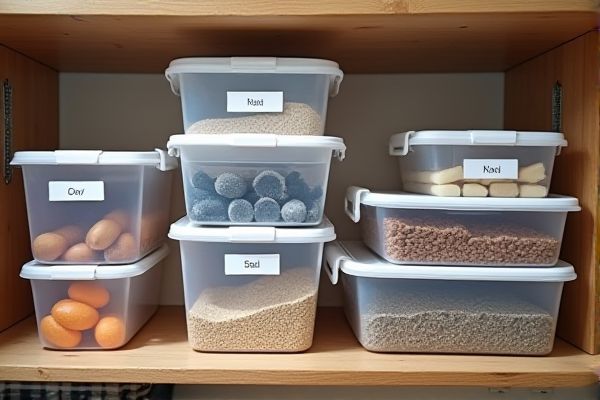
Bulk storage bins maximize space by holding large quantities of items in a single, open container, ideal for storing bulky or uniformly sized objects. Compartment bins offer segmented spaces that enhance organization and prevent mixing of smaller parts, making them perfect for detailed sorting and easy access--explore the rest of the article to determine which bin type suits Your storage needs best.
Table of Comparison
| Feature | Bulk Storage Bins | Compartment Bins |
|---|---|---|
| Purpose | Store large quantities of single items | Organize multiple small items separately |
| Design | Single, large open space | Divided into multiple smaller compartments |
| Ideal For | Bulk materials, parts, or products | Small hardware, fasteners, and components |
| Accessibility | Easy access but less organized | Structured access per compartment |
| Space Efficiency | Requires more space for large volume | Maximizes vertical and horizontal space |
| Inventory Management | Good for large volume tracking | Excellent for item-specific tracking |
| Common Materials | Plastic, metal, or wood | Plastic or metal with removable dividers |
| Use Cases | Manufacturing, agriculture, wholesale | Electronics, hardware stores, workshops |
Introduction to Bulk Storage Bins and Compartment Bins
Bulk storage bins offer a spacious solution designed for storing large quantities of materials in a single container, ideal for industries requiring high-volume inventory management. Compartment bins feature multiple divided sections within one unit, allowing organized storage of smaller parts or items, enhancing accessibility and sorting efficiency. Your choice should depend on whether you need to store bulk materials in one space or organize diverse smaller components separately for streamlined retrieval.
Key Differences Between Bulk and Compartment Bins
Bulk storage bins maximize capacity by holding large quantities of loose or unorganized items without dividers, ideal for storing materials like grains, hardware, or recycled goods. Compartment bins feature multiple sections separated by dividers, enabling the organization of small parts, tools, or inventory with easy access and sorted storage. The primary difference lies in their structure and use: bulk bins emphasize volume and simple access, while compartment bins prioritize sorting, separation, and efficient retrieval of individual items.
Space Efficiency: Bulk vs Compartment Storage
Bulk storage bins maximize space efficiency by utilizing large, uninterrupted volumes ideal for storing loose or bulk items, reducing wasted space between containers. Compartment bins optimize organization for smaller, varied components, but their multiple partitions can limit total storage capacity. Choosing between bulk and compartment bins depends on balancing the need for space utilization against the requirement for item separation and accessibility.
Material Types and Durability Comparison
Bulk storage bins are typically made from high-density polyethylene (HDPE) or steel, offering exceptional durability and resistance to impact, chemicals, and extreme temperatures, making them ideal for heavy-duty industrial use. Compartment bins are often constructed from polypropylene or lighter plastics, providing moderate durability with greater organizational flexibility but less resistance to harsh conditions. Your choice depends on whether you prioritize rugged material strength for heavy loads or the convenience of multiple compartments for smaller parts storage.
Accessibility and Organization Features
Bulk storage bins offer easy accessibility by allowing you to quickly grab large quantities of items without sorting, making them ideal for high-volume storage needs. Compartment bins enhance organization by dividing contents into multiple sections, reducing clutter and simplifying item retrieval. Your choice depends on whether you prioritize rapid access or detailed categorization for efficient storage management.
Application Suitability: Industries and Use Cases
Bulk storage bins excel in industries like agriculture, manufacturing, and construction where large volumes of materials such as grains, raw materials, or bulk hardware components need to be stored and accessed efficiently. Compartment bins are ideal for electronics, pharmaceuticals, and small parts inventory management, offering organized separation of items to streamline assembly lines and improve inventory accuracy. Selecting the appropriate bin type enhances operational efficiency by matching storage solutions to specific industry demands and use cases.
Cost Analysis: Initial Investment and Maintenance
Bulk storage bins typically have a lower initial investment due to their simpler design and larger capacity, reducing the cost per unit stored. Compartment bins, while more expensive upfront, offer organized storage that can minimize maintenance by preventing product damage and easing inventory management. Your choice should balance these factors, considering long-term savings versus immediate expenses.
Flexibility and Customization Options
Bulk storage bins offer high flexibility for storing a wide variety of large or irregularly shaped items without predefined divisions, allowing you to maximize space based on item size. Compartment bins provide superior customization with adjustable dividers that organize smaller parts and components efficiently, minimizing mix-ups and improving inventory management. Choosing between these options depends on your specific storage needs for versatility or detailed organization.
Safety and Handling Considerations
Bulk storage bins offer efficient handling of large quantities but may pose safety risks due to heavy lifting and limited visibility inside the bin. Compartment bins reduce the risk of cross-contamination and improve organization, enhancing safety by minimizing the need for excessive manual sorting. Your choice should align with traffic flow and ergonomic practices to optimize both safety and handling efficiency.
Choosing the Right Bin: Factors to Consider
When choosing between bulk storage bins and compartment bins, consider factors such as the type and volume of items to be stored, ease of access, and space efficiency. Bulk storage bins are ideal for larger, uniform items and maximize space, while compartment bins provide organized separation for smaller parts, preventing mixing and simplifying inventory management. Assessing the specific storage needs, item sizes, and workflow requirements ensures optimal bin selection for improved organization and productivity.
 homyna.com
homyna.com